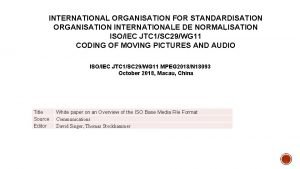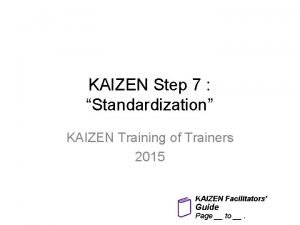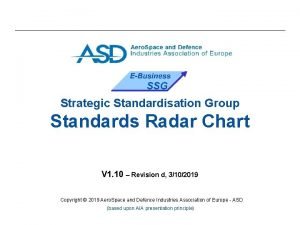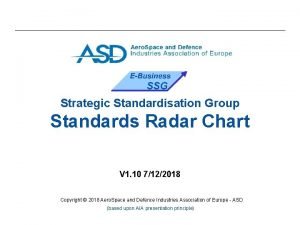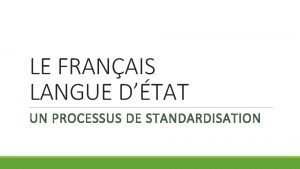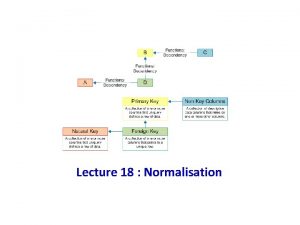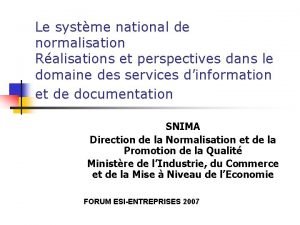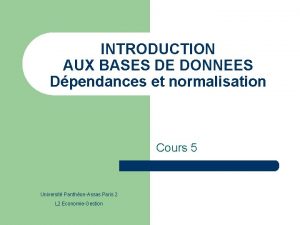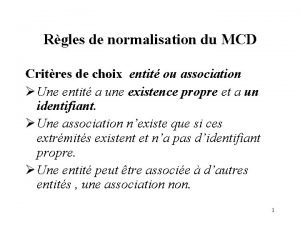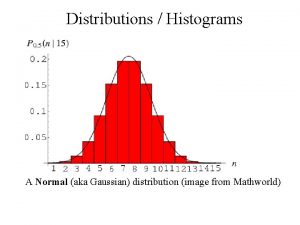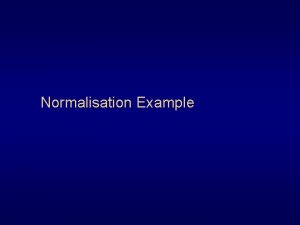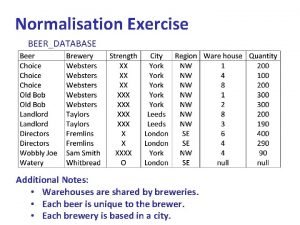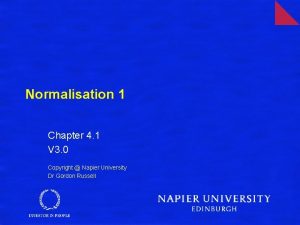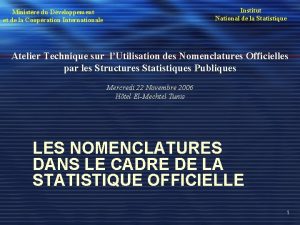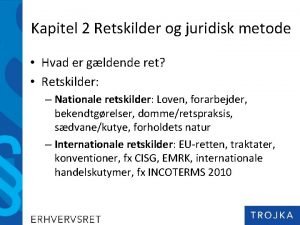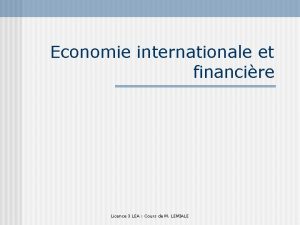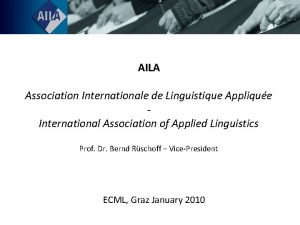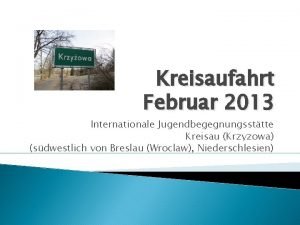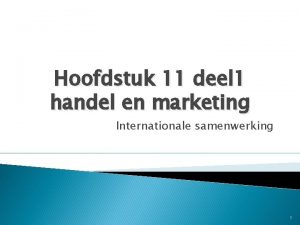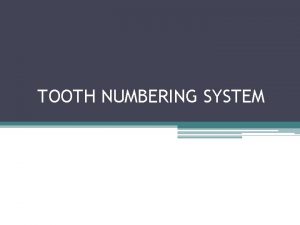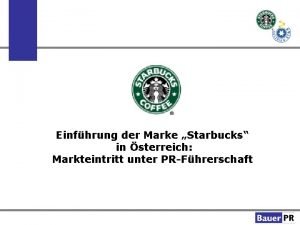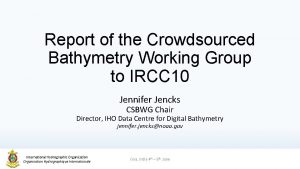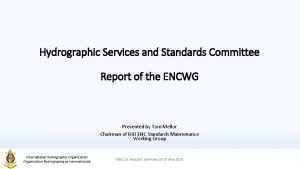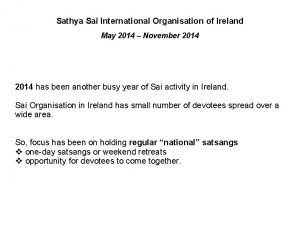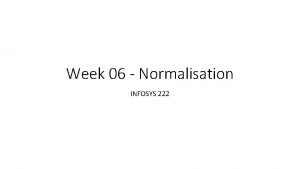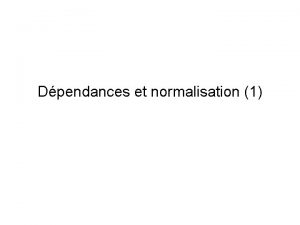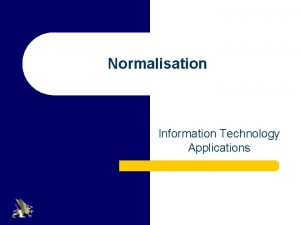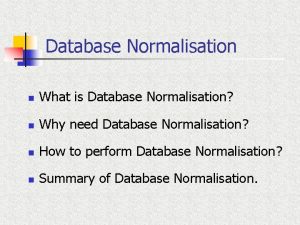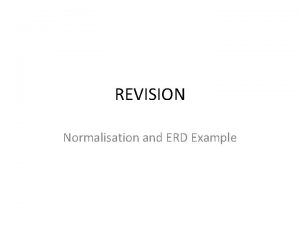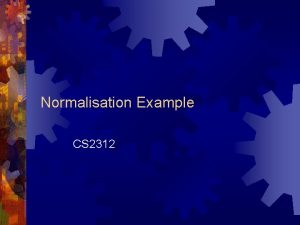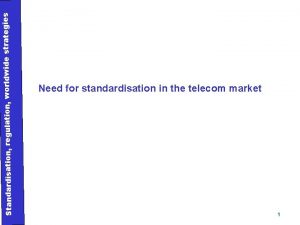INTERNATIONAL ORGANISATION FOR STANDARDISATION ORGANISATION INTERNATIONALE DE NORMALISATION

































![§ Media Source Extension (MSE) § This specification extends HTMLMedia. Element [HTML 51] to § Media Source Extension (MSE) § This specification extends HTMLMedia. Element [HTML 51] to](https://slidetodoc.com/presentation_image/314d0b6936c2abd2da5b63414919ad1c/image-34.jpg)














- Slides: 48

INTERNATIONAL ORGANISATION FOR STANDARDISATION ORGANISATION INTERNATIONALE DE NORMALISATION ISO/IEC JTC 1/SC 29/WG 11 CODING OF MOVING PICTURES AND AUDIO ISO/IEC JTC 1/SC 29/WG 11 MPEG 2018/N 18093 October 2018, Macau, China Title Source Editor White paper on an Overview of the ISO Base Media File Format Communications David Singer, Thomas Stockhammer

… more then just a collection of Boxes Reflecting the status in August 2018

§ Basics and History § Structures and Principles § More than just a paper spec – Tools and Deployments § ISO BMFF and streaming § Other recent application formats § Crystal Ball – What’s next? § Summary

§ The ISO Base Media File Format contains structural and media data information principally for timed presentations of media data such as audio, video, etc. § There is also support for un-timed data, such as meta-data. § By structuring files in different ways the same base specification can be used for files for § § § capture; exchange and download, including incremental download and play; local playback; editing, composition, and lay-up; streaming from streaming servers, and capturing streams to files. ISO base media file format (MPEG-4 Part 12) also known as ISO BMFF Developed by ISO Type of format Media container Container for Audio, video, text, data Extended from Quick. Time. mov Extended to MP 4, 3 GP, 3 G 2, . mj 2, . dvb, . dcf, . m 21, . cmf Standard ISO/IEC 14496 -12, ISO/IEC 15444 -12 Website https: //www. iso. org/standard/68960. html

§ ISO BMFF is directly based on Apple’s Quick. Time container format. § It was developed by MPEG (ISO/IEC JTC 1/SC 29/WG 11). § first MP 4 file format specification was created on the basis of the Quick. Time format specification published in 2001. § The MP 4 file format known as "version 1" was published in 2001 as ISO/IEC 14496 - 1: 2001, as revision of the MPEG-4 Part 1: Systems. § In 2003, the first version of MP 4 file format was revised and replaced by MPEG-4 Part 14: MP 4 file format (ISO/IEC 14496 -14: 2003), commonly known as MPEG-4 file format "version 2". [13] § The MP 4 file format was generalized into the ISO Base Media File format (ISO/IEC 14496 -12: 2004 or ISO/IEC 15444 -12: 2004), which defines a general structure for time -based media files.

MPEG-4 Part 12 / JPEG 2000 Part 12 editions Edition Release date Standard Main Features First edition 2004 ISO/IEC 14496 -12: 2004, ISO/IEC 15444 -12: 2004 Initial base spec Second edition 2005 ISO/IEC 14496 -12: 2005, ISO/IEC 15444 -12: 2005 ? ? ? Third edition 2008 ISO/IEC 14496 -12: 2008, ISO/IEC 15444 -12: 2008 ? ? ? Fourth edition 2012 ISO/IEC 14496 -12: 2012, ISO/IEC 15444 -12: 2012 Font streams, subtracks and colors, DASH, reception hint tracks Fifth edition 2015 ISO/IEC 14496 -12: 2015, ISO/IEC 15444 -12: 2015 Sixth edition 2018 (expected) Supported by Amendments and Corrigendas Timed text and better audio DRC and HEIF

Timed text and other visual overlays in ISO base media file format (14496 -30) CMAF 23000 -19 Common encryption in ISO base media file format files (23001 -7) DASH 23009 -1 MMT 23008 -1 OMAF 23090 -2

Logical, Timing and Physical Structures

§ The files have § a logical structure: a movie that in turn contains a set of time-parallel tracks. § a time structure: the tracks contain sequences of samples in time, and those sequences are mapped into the timeline of the overall movie by optional edit lists. § a physical structure; a series of boxes (sometimes called atoms), which have a size and a type. § These structures are not required to be coupled.

§ Each media stream is contained in a track specialized for that media type (audio, video etc. ), and is further parameterized by a sample entry. § The sample entry § contains the ‘name’ of the exact media type (i. e. , the type of the decoder needed to decode the stream) and any parameterization of that decoder needed. § The name also takes the form of a four-character code. § There are defined sample entry formats not only for MPEG-4 media, but also for the media types used by other organizations using this file format family. § They are registered at the MP 4 registration authority. § Tracks (or sub tracks) may be identified as alternatives to each other, and there is support for declarations to identify what aspect of the track can be used to determine which alternative to present, in the form of track selection data.

File Track Sample Item • Contains • timed data in tracks of a movie • Other data (untimed) in items • Or a combination of both • Defines a common timeline for all tracks to be synchronized • Corresponds to a specific media type (codec), • Is associated to a single decoder (except for scalable codecs), • May be linked, grouped or alternative to other tracks • May have associated untimed data in items • May be encrypted • Is decomposed into samples • Represents contiguous data used by a decoder at given times (DTS, CTS) • Has properties (size, position, random access, decoder configuration…) • May be described in terms of subsamples • May be associated to other similar samples in sample groups • May have samplespecific auxiliary information • Represents data consumed as a whole and valid for the entire duration of the movie, • Has properties (type, position, size …) • May be encrypted, compressed, … meta data Movie information media data Item Video information track 01 Audio information track 02 video & audio samples

§ Data is stored in a basic structure called box § No data outside of a box § Each box has length, type (4 printable chars), possibly version and flags, and data § Extensible format: § Unknown boxes can be skipped (syntactically) § Header information is a hierarchical set of boxes (typically ‘moov’ or ‘meta’) § Media data is stored unstructured, in boxes (mainly ‘mdat’, or ‘idat’) in the same file as the header or may be stored in a separate file



§ Each track is a sequence of timed samples; § each sample has a decoding time, and may also have a composition (display) time offset. Edit lists may be used to over-ride the implicit direct mapping of the media timeline, into the timeline of the overall movie. § Sometimes the samples within a track have different characteristics or need to be specially identified. § One of the most common and important characteristic is the synchronization point (often a video I- frame). § These points are identified by a special table in each track. § More generally, the nature of dependencies between track samples can also be documented. § Finally, there is a concept of named, parameterized sample groups. § Each sample in a track may be associated with a single group description of a given group type, and there may be many group types.

Segment § ISO BMFF has three timelines § Decode times § Composition times § Movie/Presentation time § ISO BMFF provides § Decode deltas/times § Composition offsets (may be negative) § Edit Lists signaled in movie header § The presentation time for synchronized presentation is obtained as § DT + CO + EL /-- ------ I 3 P 1 P 2 P 6 B 4 B 5 Presentation |==| P 1 P 2 I 3 B 4 B 5 P 6 |==| Order Base media 0 decode time /- ------ -- I 9 P 7 P 8 P 12 B 10 B 11 P 7 P 8 I 9 B 10 B 11 P 12 |==| 60 Decode Delta 10 DT 0 EPT 10 10 20 10 30 10 40 10 50 10 60 70 10 80 10 90 10 10 100 110 Composition time offset CT 30 0 0 30 10 20 60 40 50 90 70 80 120 100 110 Segment /-- ------ I 3 P 1 P 2 P 6 B 4 B 5 Presentation |==| P 1 P 2 I 3 B 4 B 5 P 6 |==| Order Base media 0 decode time Decode Delta 10 DT 0 EPT 0 10 10 10 20 Composition offset CT 20 -10 20 20 0 10 10 30 50 10 40 10 50 0 /- ------ -- I 9 P 7 P 8 P 12 B 10 B 11 P 7 P 8 I 9 B 10 B 11 P 12 |==| 60 10 60 60 10 70 10 90 10 10 100 110 -10 20 -10 -10 30 80 60 40 10 80 70 110 90 100

§ First, timed meta-data may be stored in an appropriate track, synchronized as desired with the media data it is describing. § See for example for 23001 -10 for timed metadata, e. g. Region of interest, location, etc. § support for non-timed collections of metadata items attached to the movie or to an individual track. § The actual data of these items may be in the metadata box, elsewhere in the same file, in another file, or constructed from other items. § these resources may be named, stored in extents, and may be protected. § These metadata containers are used in the support for file-delivery streaming, to store both the ‘files’ that are to be streamed, and also support information such as reservoirs of pre-calculated forward error-correcting (FEC) codes (e. g. hint tracks) § The generalized meta-data structures may also be used at the file level, § above or parallel with or in the absence of the movie box. § In this case, the meta-data box is the primary entry into the presentation.

© Microsoft

§ Simple extensions: § § § New codec for temporal data for which you own the sample format (e. g. AV 1 in MP 4) New sample groups for (codec-specific) annotation of samples (e. g. HEVC CRA/BLA) New sample auxiliary data , for (codec-specific) per-sample data (e. g. init vector, …) New untimed data format (e. g. EXIF, XMPP …) New user-, vendor-specific data (use ‘meta’, ‘udta’, ‘free’, ‘skip’, or ‘uuid’ boxes) § Harder extensions § Beware of backwards compatibility ! § Only if all other options have been exhausted § Extending existing boxes: Use versioning and/or flags § New boxes (almost always the wrong option!) § § § Check for name clashes (www. mp 4 ra. org) Define box syntax and semantics Choose box location and cardinality Timed/Untimed information File level, segment level, movie level, track level, sample level, … Define new brand if it implies behavior changes/incompatibilities

§ Carriage of network abstraction layer (NAL) unit structured video in the ISO base media file format § Defines not only what a sample is, but also has various options § Parameter sets in the sample entry (initialization), or in-stream § Out-of-band mechanism: identified by the use of ‘avc 1’ or ‘hvc 1’ § Inband parameter sets: identified by ‘avc 3’ or ‘hev 1’ § Sample groups to describe samples (random access etc. ) § Defines carriage of both scalable and multi-view extensions to AVC & HEVC § Single-track or multi-track § Sample groups etc. to help choose which track(s) to consume

§ Audio: § 'mp 4 a‘ defines the set of MPEG-4 audio in the MP 4 spec 14496 -14 § Other audio technologies define the sample entry and track mapping in their media specs § Subtitles § IMSC 1 and Web. VTT see 14496 -30 § External media can be added to the ISO BMFF as well § The codecs parameter is defined in RFC 6381 § The 'Codecs' and 'Profiles' Parameters for "Bucket" Media Types § Permits signaling sample entries plus additional information § Currently under discussion – how much needs to be there for capability

Movie Box (‘moov’) § specifies elementary stream encryption Protection Specific Header Box(‘pssh’) and encryption parameter storage to enable a single ISO Media file that support different Digital Rights Management systems (DRM) to manage keys and securely decrypt the media. § Clear and encrypted byte ranges are identified in the track metadata as “subsamples” § First edition: ‘cenc’ - single encryption scheme using AES- 128 counter mode cipher § Second edition: ‘cbc 1’ using AES-128 with Cipher Block Chaining mode (CBC) § Third edition: two pattern encryption schemes, identified as ‘cbcs’ and ‘cens’ Container for individual track (‘trak’) x [# tracks] … Container for media information in track (‘mdia’) Media Information Container (‘minf’) Sample table box, container of the time / space map (‘stbl’) Protection Scheme Information Box (‘sinf’) Scheme Type Box (‘schm’) Scheme Information Box (‘schm’) Track Encryption Box (‘tenc’)

Tools and Software

§ Conformance bit streams § ISO/IEC 14496 -4 § Some streams are freely available § § http: //standards. iso. org/ittf/Publicly. Available. Standards/ More are welcome Software § ISO/IEC 14496 -5 § Reference software, freely available § C, ISO Licence § Read/Write MP 4 files § Contributions are welcome MP 4 Registration Authority http: //www. mp 4 ra. org § There is a registration authority which registers and documents the four-character-code-points used in this file-format family, as well as some other code-points related to MPEG-4 systems. § The database is publicly viewable and registration is free.

§ Open Source § Widely implemented in open source, e. g. FFMpeg, MP 4 Box § Nokia Labs even has a Javascript implementation § Usage in Commercial Services § tbd § Check here: http: //mp 4 ra. org/#/brands

DASH and CMAF

1 Encode each video at multiple bitrates 5 Client makes decision 6 Client acquires a 4 Make each segment on which segment to license for encrypted addressable via an download HTTP-URL content 2 Split the videos into small segments 7 Client splices together and plays back 001010100001 010 0010101000 0101010100 01110 0010101000 01010001 110 011101000110 10101 0111010001 10101010100 0111010001 1010101 3 Encrypt each segment Media Capture and Encoding DRM Encryption Server Media Origin Servers HTTP Cache Servers Client Devices DRM License Server © Microsoft

§ Object Oriented – flexible and extensible structures called “boxes” used for sequencing § § media data along with nested metadata allowed specification of independently decodable “movie fragments” (DASH “Segments”) Extensible metadata model – that allowed adding information for live streaming, encryption, subtitles, new codecs, etc. , separate from media data Extensible timing model – presentation time is the sum of previous sample durations, allowing time to be calculated on playback … not a timestamp recorded on each sample Interoperable file “brands” – identifying sets of new boxes that enable adaptive streaming, Common Encryption, new codecs, live streaming, etc. with well-defined interoperability Enabled creation of a Multimedia Presentation Application Model consisting of a Media Object Model and Media Timeline Model that support late binding of adaptive multimedia presentations with a single set of media objects enabling a variety of delivery methods, such as file download, track download, multicast/broadcast, and adaptive streaming

ftyp moov Initialization Segment moof mdat Media Segment Representation moof mdat Media Segment


§ To avoid combinatorial complexity or useless downloads, tracks are offered individually on cloud § Client selects relevant tracks and synchronizes playout Audio Selection Set Subtitle Selection Set English AAC stereo CMAF Switching Set (single Track) French AAC stereo CMAF Switching Set (single Track) English multichannel CMAF Switching Set (single Track) French multichannel CMAF Switching Set (single Track) English Web. VTT description CMAF Switching Set (single Track) English TTML description CMAF Switching Set (single Track) French Web. VTT dub CMAF Switching Set (single Track) French TTML dub CMAF Switching Set (single Track) SD Media Profile CMAF Switching Set (multiple Tracks) Video Selection Set HD Media Profile CMAF Switching Set (multiple Tracks) UHD 10 Media Profile CMAF Switching Set (multiple Tracks)

§ Providing the ability that an application can distribute media synchronized events such as SCTE markers, simple overlays, stats, etc. Application DASH Client control, selection & heuristic logic Event Processing HTTP stack API HTTP stack Segment Parsing App Event dispatch Media decoder input buffer Media Decoder Industry current working on a consistent support for Events

MPD Encoder CNC IS CNC CIC DASH Segment CH DASH Packager CH = CMAF Header CNC CIC CNC HTTP Chunk CNC CIC CNC = CMAF non-initial chunk CIC = CMAF initial chunk 10 s More Tomo rrow 3 s Regular DASH Client Segments Low-Latency DASH Client Chunks CDN stores Segments
![Media Source Extension MSE This specification extends HTMLMedia Element HTML 51 to § Media Source Extension (MSE) § This specification extends HTMLMedia. Element [HTML 51] to](https://slidetodoc.com/presentation_image/314d0b6936c2abd2da5b63414919ad1c/image-34.jpg)
§ Media Source Extension (MSE) § This specification extends HTMLMedia. Element [HTML 51] to allow Java. Script to generate media streams for playback. § Allowing Java. Script to generate streams facilitates a variety of use cases like adaptive streaming and time shifting live streams. § Byte. Stream Format for ISO BMFF § https: //www. w 3. org/TR/mse-byte-streamformat-isobmff/ § This specification defines a Media Source Extensions™ [MEDIA-SOURCE] byte stream format specification based on the ISO Base Media File Format.


§ ISO/IEC 23008 -12 permits storage: § Sequences (e. g. bursts, brackets): as tracks, MP 4 -style § Images (coded or derived) as Items, MPEG-21 -style • Derived items • Image overlay (compose) • Image Grid • … pqrs properties initialization �� visual size abcd cdsc mirror jpeg dimg Primary Item • Coded Items • HEVC, AVC, JPEG, (JPEGXR), … jpeg • Metadata Items • EXi. F, XMP, MPEG-7, …

§ 23090 -2: Part 2 of MPEG-I Coded Representation of Immersive Media § It is a systems standard developed by MPEG that defines a media format, enables omnidirectional media applications, focusing on 360° video, images, and audio, as well as associated timed text.

§ General rules for signalling of important information § Overall omnidirectional video indication § Signalling of projection format § Signalling of region-wise packing and guard bands § Signalling of rotation § Signalling of frame packing § Signalling of content coverage § Region-wise quality ranking § Signalling of fisheye video parameters § Storage and signalling of omnidirectional images § Storage and signalling of timed text § OMAF timed metadata

The Partial File Format is designed to contain files partially received over a lossy link (with unreceived or corrupted sections), for further processing such as playback or repair. The file structure is object-oriented; a file can be decomposed into constituent objects very simply, and the structure of the objects inferred directly from their type. This format contains the correctly received data, missing block identification, and repair information such as location of the file or high-level original indexing information.

Some MPEG Activities

§ Under development § specifies how the ISO BMFF format can be used to store web resources (e. g. HTML, Java. Script, CSS, …) § specifies hypothetical processing for how these files can be consumed by web browsers, in particular how references from web resources to the file that carry them or to other web resources carried in the same file are handled. § enables the delivery of synchronized media and web resources as supported by ISO/IEC 14496 -12: file download, progressive download, streaming, broadcast, etc. Workshop planned with 3 GPP, MPEG, W 3 C, ATSC, DVB, CTA and Hbb. TV

§ Examples § Tiled 360 videos in very high resolution § Large Point Clouds that can be navigated in 6 Do. F § Lightfields with lots and lots of small tiles § A complicated Scene Graph with many objects to traverse § Audio objects can be audible, or beyond the “audio horizon” § Environment § All likely retrieved from some sort of cloud infrastructure § All of these can be available in multiple quality/bitrate variations § At the receiver all of those need to decoded and decrypted with constrained devices in an immersive experience Server/Cloud Client VR App/DASH Client Decoding Rendering

Media Resource References Timing Information Spatial Information Media consumption information Presentation Engine Sync Information Shader Information Manifest, Index, … Cloud Texture Buffer #1 Decoder Media Requests Protocol Plugin Media Retrieval Engine Texture Buffer #2 Format Plugin Decoder Vertex Buffer #1 Decoder MPEG is currently investigating storage and streaming formats for immersive media Texture Buffer #n Vertex Buffer #n Local Storage Shader Buffer Audio Decoder Sync Rendering

§ Flexibly retrieving parts of a large body of media data from a cloud resource to create a coherent user experience under constrained resources § Where constraints exist like bandwidth, access latency, decode resources (and where these can fluctuate dynamically) § With the client in charge of making trade-offs given such constraints § Where fast response times and efficiency are crucial for the Qo. E § Where inherently, data is accessed and retrieved in multiple parallel streams § Where this data may need to be protected and/or encrypted § Where this data may need to be cached close to the user for the best experience § Where the data is stored in the cloud in a distributed manner

§ Temporal random access – “as usual” § Spatial random access – retrieving only the relevant parts of the media § Depending on user orientation § Making quality/bitrate trade-offs in switching between quality levels § Depending on what is visible/audible § Depending on retrieval/device and resource constraints, including bandwidth, latency, decoder capability, things like video and audio reproduction capabilities (e. g. screen resolution and color space; speaker config) § Decoding capabilities, user preferences, etc. § Addition of static media § Different timelines § Scene Descriptions, Nodes, etc. § Which objects to retrieve – and which parts of objects § Extend the File Format or do something “NEW”? ongoing


§ Successful file format § Very versatile: from editing to HTTP streaming to broadcasting § Very extensible (codecs, usages, applications) § Very dynamic (more contributions than ever) § Some challenges § Carrying some legacy that is no longer in use § Addressing all the use cases while maintain compatibility § For certain applications and use cases, the file format principles are suboptimal in terms of overhead or processing efficiency. § The ISO BMFF is the stable glue between modern media and transport, but will evolve further for new use cases applications.

THANK YOU Thanks to Dave Singer, Kilroy Hughes, Per Fröjdh, Cyril Concolato, Ye-Kui Wang, Iraj Sodagar, Jean Le Feuvre and other contributors to the presentation
 Organisation internationale de normalisation
Organisation internationale de normalisation Organisation internationale de normalisation
Organisation internationale de normalisation Organisation internationale de normalisation
Organisation internationale de normalisation Standardisation vs adaptation in international marketing
Standardisation vs adaptation in international marketing Organisation internationale des constructeurs d'automobiles
Organisation internationale des constructeurs d'automobiles Kaizen standardisation
Kaizen standardisation Rolling plan for ict standardisation
Rolling plan for ict standardisation Standardisation of sodium hydroxide
Standardisation of sodium hydroxide Property standardisation group
Property standardisation group Standardisation vs adaptation
Standardisation vs adaptation Property standardisation group
Property standardisation group Processus de standardisation
Processus de standardisation European committee for standardisation
European committee for standardisation Determinancy diagram
Determinancy diagram Système de normalisation
Système de normalisation Normalisation des données définition
Normalisation des données définition Fixed point notation
Fixed point notation Risk normalization examples
Risk normalization examples Mcd location de voiture
Mcd location de voiture Normal distribution image
Normal distribution image Normalisation
Normalisation Normalisation
Normalisation Normalisation
Normalisation Marktentreestrategie
Marktentreestrategie Classification internationale type des professions
Classification internationale type des professions Isa internationale standardatmosphäre
Isa internationale standardatmosphäre Alphabet aéronautique international
Alphabet aéronautique international Internationale retskilder
Internationale retskilder économie internationale licence 3
économie internationale licence 3 Association internationale de linguistique appliquée
Association internationale de linguistique appliquée Saint sacrement 2022
Saint sacrement 2022 Internationale jugendbegegnungsstätte krzyzowa
Internationale jugendbegegnungsstätte krzyzowa Internationale gebrauchshunde prüfungsordnung
Internationale gebrauchshunde prüfungsordnung Marketing internationale
Marketing internationale Alliance internationale de tourisme
Alliance internationale de tourisme Tooth numbering system
Tooth numbering system Cz internationale zorgpas
Cz internationale zorgpas Internationale competenties
Internationale competenties Opleidingsdocument social work
Opleidingsdocument social work Starbucks internationale strategie
Starbucks internationale strategie Aeroporturi internationale romania
Aeroporturi internationale romania école internationale wilfrid-pelletier
école internationale wilfrid-pelletier Oferte orange roaming
Oferte orange roaming Gestion internationale des ressources humaines cours
Gestion internationale des ressources humaines cours Objectives of ilo
Objectives of ilo International hydrographic organisation
International hydrographic organisation International business organisation
International business organisation International hydrographic organisation
International hydrographic organisation Sathya sai international organisation uk
Sathya sai international organisation uk

